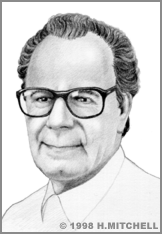Gordon Gould
Gordon Gould was born in New York City in 1920. As a child, he idolized Thomas A. Edison and other inventors, with the encouragement of his mechanically-minded mother. Later, Gould himself would conceive and design one of the most significant inventions of the 20th century: the laser.
In 1957, Gould was working toward a PhD in Physics at Columbia University, where Physics research was booming. Among others, Charles Townes, the inventor of the maser (1951), was teaching there. Gould, whose former specialty was classical optics, was doing research in microwave spectroscopy. One Saturday night, Gould was inspired "in a flash" with a revolutionary idea: Light Amplification by Stimulated Emission of Radiation, or the "laser."
A light-wave amplifier would be much more powerful than a maser (which amplifies microwaves), since every photon of light has a hundred thousand times more energy than a photon of microwave energy. By the end of that weekend, Gould had designed a device that he predicted could heat a substance to the temperature of the sun in a millionth of a second.
Fearing competition, Gould abandoned his doctorate in order to focus on bringing his invention into production quickly. He spent 1958 refining and improving his model, but he did not file for a patent until 1959, believing that he had to build a prototype before filing. Unfortunately, this resulted in a 20-year legal battle, which Gould finally won in 1977, when the first of his laser patents was issued.
By then, Gould's laser technology was already being used in countless practical applications, including welding, scanning, and surgery. But he had not been idle meanwhile. As professor at the Polytechnic Institute of New York (1967-1973), Gould founded the laser research lab and an entire new department. In 1973, Gould co-founded an optical communications company, where he earned additional patents before retiring in 1985. He was inducted into the National Inventors Hall of Fame in 1991. Gould died on September 16, 2005.


